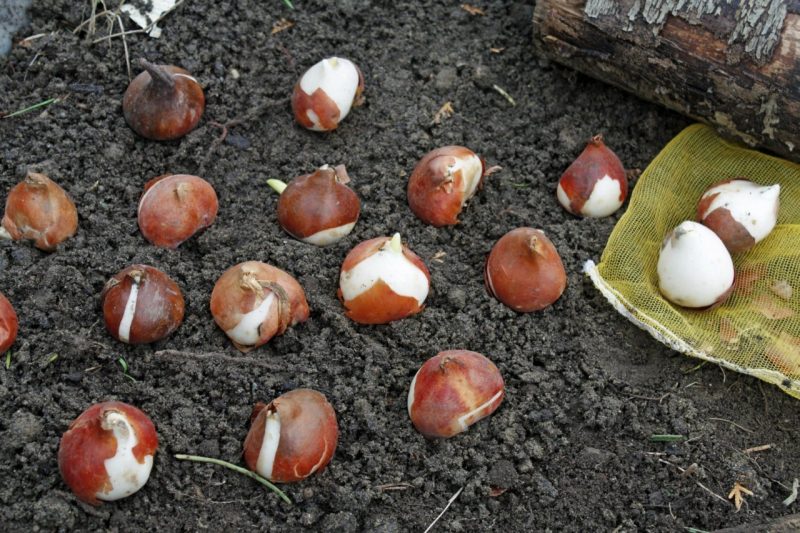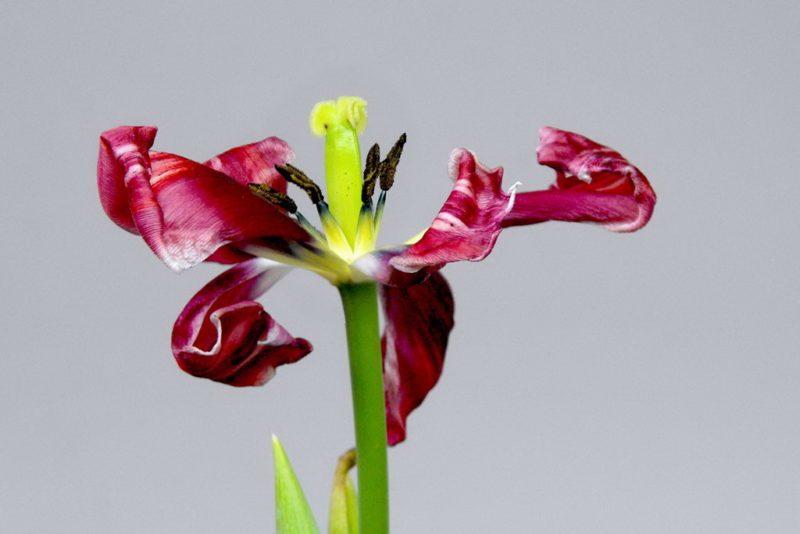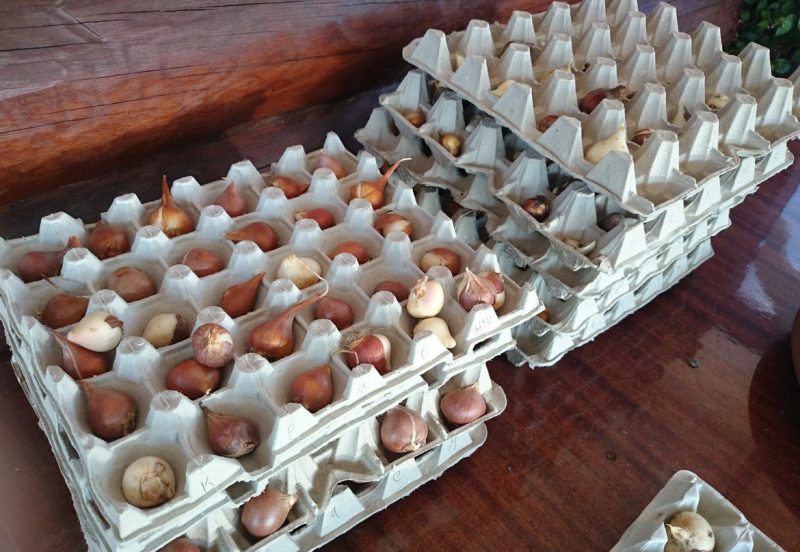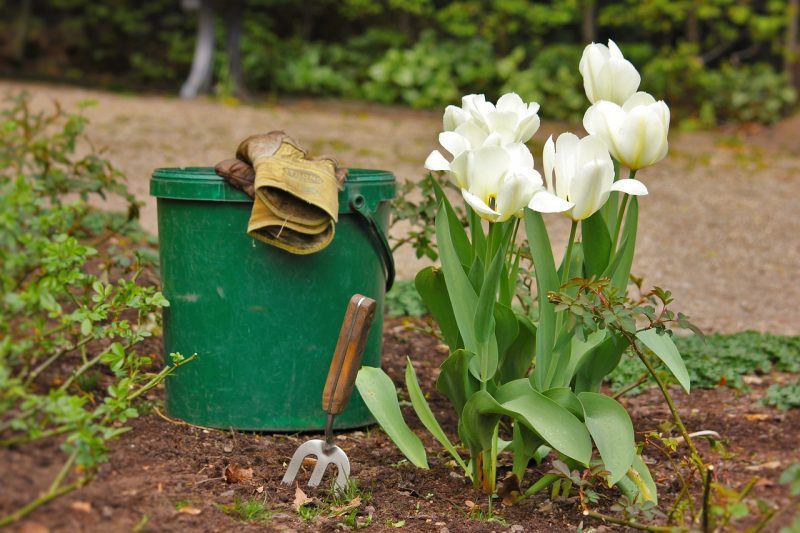Every amateur gardener should know the features of growing tulips in the open field. These lovely flowers are among the first to please in the spring. But if before, in the Soviet years, Dutch tulips lit up with red lights in flower beds, and then “yellow ones” were added to them, today the choice of varieties is unusually large. You can choose flowers of any shade - from white to black, and any shape. Early, middle and late tulips in their flowering will succeed each other and for a long time please the owners with a bright flowerbed.

Well and of course. flower garden owners want tulips to grow normally, develop and not hurt. What needs to be done for this? So, tulips - planting and care in the open field for these "first-born of spring."
Material Content:
The choice of bulbs for planting
Bulbs can be either their own, grown on their own site, or acquired - of certain varieties. The main thing is that they are healthy. First of all, they are carefully examined.

Bulbs that have begun to rot or are affected by fungal diseases are thrown away.
The rest are sorted by size.
Large bulbs will grow tulips that bloom in spring. Plants will form from small ones, flowering of which should be expected in the next season.
Time and date of planting tulips
Typically, plants are planted in open ground in spring or autumn. The same applies to tulips.
Fall
This is the best option for planting plants in central Russia. Tulip bulbs are planted in their designated place, starting in mid-September and ending in mid-October.Of course, the dates can be extended if the autumn is warm, and shortened in case of unexpected onset of cold weather. The soil temperature should not fall below + 7-10 C, otherwise the root system of the bulbs will not have time to take root, and the flowers will freeze.
But subject to the rules, planting tulips in the fall will allow you to get strong and healthy flowers next spring.
In the spring
Tulip bulbs can be planted in the spring, when the earth warmed up to the same + 7-10 C. Usually this happens in the second half of April-early May. Do not rush to land so that tulips do not die during frosts.
How to plant tulips?
Tulips are quite undemanding plants. Therefore, even a beginner grower will cope with their planting.
Soil requirements
Tulip bulbs prefer a relatively light, slightly alkaline soil. Sandy will not work - such soil will have to be enriched with peat or humus, but sandy loam will fit perfectly.
Heavy clay soils are also not very suitable for tulips - they stagnate moisture, which can lead to rotting of the bulbs. When digging a bed with such land, it is best to make river sand. As drainage can be used: crushed bark, sawdust, polystyrene crumbs.
It is good for a year or two before planting tulip bulbs to sow the designated area for them with siderat plants, and then dig them along with the soil. So you can be sure that the necessary nutrients are added to the soil.
Seat selection
The place for tulips should be quite sunny. These plants are demanding of light. In shaded areas, they stretch out, the flowers become small, the petals quickly crumble.

If tulips are to be grown on a flower bed next to tall plants, you should consider this point and make sure that tulips do not appear in the shade.
Tulips grow poorly on slopes - the site should be flat. Also, stagnation of water in the garden is contraindicated.
Outdoor landing
Before landing in open ground - a bed is prepared. If the plot is acidic, the ground is sprinkled with lime. A couple of months before planting make humus. But here too it is impossible to overdo it: tulips belong to plants that are better to underfeed than to overfeed.

So what are the main rules?
- The bed should be about 15 cm high, at least 1 m wide, and the distance between the beds should ideally be about 50 cm.
- Furrows are made in the beds, the depth of which reaches the height of 4 bulbs. Furrows are shed abundantly with water. And the bulbs before planting are kept in a weak solution of potassium permanganate to disinfect.
- It is advisable to sprinkle the furrows with river sand, you can use a crumb of foam.
- Bulbs are planted at a distance of 6-7 cm from each other.
- Furrows fall asleep.
- The beds are covered with a layer of mulch. You can use compost, sawdust, chopped bark.
In the event that winters are frosty in these places, tulips - during autumn planting - are additionally covered with a layer of beautiful foliage. It must be remembered that it is impossible to use manure that has not yet been quail when caring for tulips. Bulbs will suffer from fungal diseases.
Tulip Care

After autumn planting - until spring, tulips will no longer require care. You can recall them in March, when the snow begins to thaw in the sun. Many flower growers consider this time optimal for the first fertilizer application. Together with meltwater, they penetrate deep into the soil, and just at the right time - when the tulips begin to develop and gain color.
Watering and feeding
Tulip care is easy. These plants love water, so you need to water them regularly and in sufficient quantities. It is undesirable to use a garden hose for this purpose, it is better to take an old watering can. On 1 sq.m. About 20-30 liters of water are introduced. It is recommended to use water that has settled down, warmed up to about air temperature.
Today, Nature stores sell many fertilizers suitable for tulips. Among them there are fertilizers that dissolve in water, or are used in dry form.
Experienced flower growers feed tulips three times a season.
The first time, as already mentioned, dry fertilizers can be applied directly to the snow. Their composition should include nitrogen, phosphorus, potassium, in a ratio of 2: 2: 1.
The second time the tulips feed when the buds are visible. It uses the same trace elements, that is, nitrogen, phosphorus and potassium, only the ratio is already different: 1: 2: 2.
The third time fertilizers are applied when most of the flowers in the garden begin to drop their petals. Now tulips need only phosphorus and potassium in equal proportions.
It must be remembered that nitrogen is contained in ammonium nitrate, and superphosphate is the best source of phosphorus.
You can also use complex fertilizers, which include manganese and zinc.
Loosening
Slightly loosen the soil on the tulip bed shortly after planting. This will help better rooting of the bulbs.
In spring, the beds are loosened when the soil begins to dry out. This provides air access to the roots of plants.
Features after flowering
It may seem that after flowering ends, the tulips plunge into deep “hibernation” until the next season. But no, they still need care.

After the tulips have bloomed, you need to cut the stems, and a couple of weeks to water the plants well. This period also accounts for the third, final top dressing.
Then yellowed leaves are pruned under the root.
When to dig tulip bulbs?
This is done around mid-July. In early tulips - you can dig bulbs 10-14 days earlier than in later ones. It is important that the yard is a warm and dry day. The dirt from the bulbs is removed, and then they are treated with a weak solution of potassium permanganate and dried.
Storage conditions
Now the flower grower will have to carry out important work, on which it depends on whether his bed with tulips will be good next year.
For storing bulbs, it is advisable to have boxes in which instead of the bottom a grid is fixed. Bulbs are first sorted by variety, and then by size - adults and children, stacking them separately - in 1-2 rows.
Each bulb should be carefully inspected to there was no rotten or affected fungus between the healthy ones - it would infect the rest. Bulbs that have received mechanical damage, for example, shovels cut by a blow, are also thrown out.

At the end of the process, labels with the names of the varieties are fixed in the boxes.
For a couple of weeks, the bulbs are stored at normal summer temperatures, in a room with good ventilation. Harvest should dry well.
In late summer and early autumn, the temperature can be reduced to + 18-20 C. At the same time, the bulbs continue to be periodically examined, immediately removing the diseased.
It is advisable to plant tulips every fall in a new place, and return to the same bed in 3-4 years.
Protection against diseases and pests
So that tulips do not get sick with a number of diseases, you need to provide them with good care. For example, if drainage is sufficient, the bulbs will not rot in the warm season and will not freeze in the cold.
With proper watering, when water does not get on the leaves, sunburn spots will not appear on them.

From the attack of pests, such as aphids or slugs, tulips will protect special preparations. The flower grower must acquire a sprayer to process the ground part of the plant. The granules of the “Thunderstorm”, which reliably fights slugs, are scattered around the bed. From the bear traps help.
Among the infectious diseases of tulips, gray rot and typhulosis are the most common. Flowers are treated with drugs such as topsin or foundationazole. This should be done before the tulips have blossomed, or after flowering has ended.
Viral diseases are even more dangerous.As a result of them, the so-called “petal petals” may appear, as a result of which the variety will be permanently lost. Such tulips are dug up and destroyed.
Thus, even a novice grower can successfully plant and grow any varieties of tulips. It is only important to adhere to the basic rules. Growing tulips is a fascinating process, which many gardeners are enthusiastically given to.












